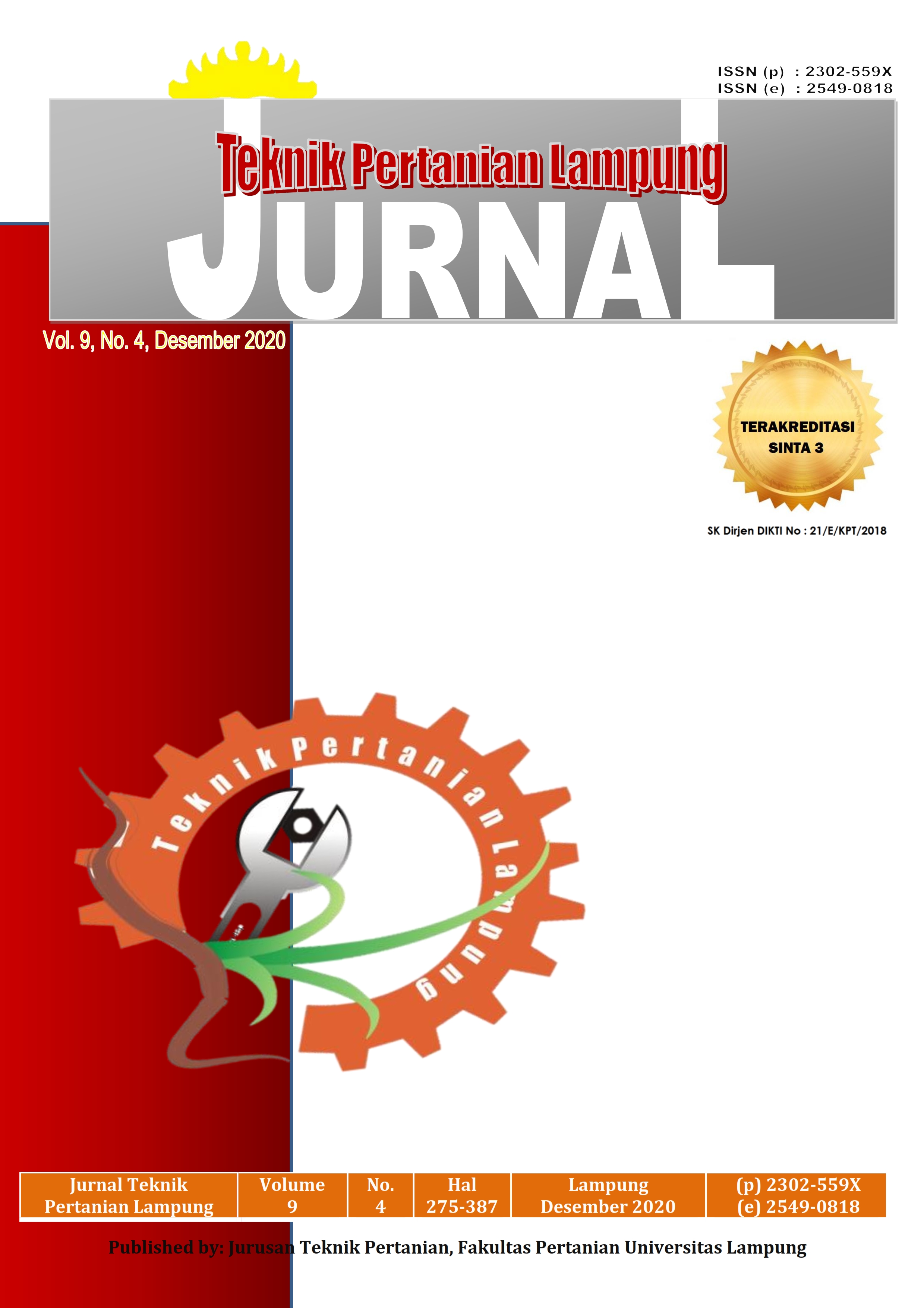PENGEMBANGAN PERANGKAT OTOMASI MITER GATE PADA SALURAN IRIGASI DENGAN TEKNOLOGI PUSH NOTIFICATIONS
DOI:
https://doi.org/10.23960/jtep-l.v9i4.317-325Abstract
Pintu air Leonardo da Vinci Miter Gate memiliki desain yang dianggap efektif menahan air. Adanya perkembangan teknologi yang sangat pesat menjadikan push technology mudah diterapkan dalam sistem yang terintegrasi dengan internet. Penelitian ini bertujuan untuk mengembangkan perangkat otomasi pintu air irigasi menggunakan model Leonardo da Vinci Miter Gate dan pengiriman informasi melalui push technology. Penelitian ini dilakukan melalui lima tahapan yaitu: studi literatur, rancangan fungsional, rancangan struktural, analisis teknik, dan pengujian sistem otomasi dengan menggunakan Arduino UNO, Sensor ultrasonic HC-SR04, Motor Servo dan Router sebagai perangkat utama dalam penelitian ini. Penelitian ini menggunakan metode rekayasa dan menghasilkan purwarupa saluran irigasi dan pintu air model Leonardo da Vinci Miter Gate dan integrasi dengan perangkat otomasi berhasil menghasilkan informasi yang dapat dibaca pengguna melalui layer LCD ataupun melalui smartphone. Temuan dari hasil pengujian adalah terjadinya kebocoran pada pintu sebesar 5-8% dari debit inlet. Pada rancangan fungsional sensor, aktuator dan pemantauan data ketinggian muka air berjalan sesuai dengan skrip yang ditulis dan menghasilkan rata-rata penerimaan notifikasi selama 3 detik setelah pengiriman informasi.
Kata Kunci: Arduino UNO. Leonardo Da Vinci, miter gate, push notification
References
Ali, M. H. 2011. Practices of Irrigation dan On-farm Water Management: Volume 2. Springer.
Ardiansah, I., Bramadi, R., Wargadibrata, N., Asdak, C., Rahmah, D. M., dan Putri, S. H. 2018. Partisipasi Petani Terhadap Pengelolaan Air Irigasi Di Kecamatan Rancaekek, Kabupaten Bandung, Provinsi Jawa Barat. Jurnal Sains, Teknologi Dan Industri, 16(1), 7–14.
Ardiansah, I., dan Putri, S. H. 2016. Perbandingan Analisis SWOT Antara Platform Arduino UNO dan Raspberry Pi. Prosiding Seminar Nasional MIPA 2016.
Bafdal, N., Dwiratna, S., dan Sarah, S. 2019. Impact of Rainfall Harvesting as a Fertigation Resources using Autopot on Quality of Melon (Cucumis melo L). International Conference on Food Agriculture and Natural Resources (FAN).
Hadihardjaja, J. 1997. IRIGASI dan BANGUNAN AIR. Penerbit Gunadarma.
Hariany, S., Rosadi, B., dan Arifaini, N. 2011. Evaluasi Kinerja Jaringan Irigasi Di Saluran Sekunder Pada Berbagai Tingkat Pemberian Air Di Pintu Ukur. Rekayasa: Jurnal Ilmiah Fakultas Teknik Universitas Lampung, 15(3), 225–236.
Kakumanu, K. R., Kaluvai, Y. R., Nagothu, U. S., Lati, N. R., Kotapati, G. R., dan Karanam, S. 2018. Building Farm-Level Capacities in Irrigation Water Management to Adapt to Climate Change. Irrigation and Drainage, 67(1), 43–54. https://doi.org/10.1002/ird.2143
Kuligowski, S. 2012. Leonardo da Vinci: Renaissance Artist and Inventor. Teacher Created Materials.
Ma, D. 2012. Use of RSS feeds to push online content to users. Decision Support Systems, 54(1), 740–749. https://doi.org/10.1016/j.dss.2012.09.002
Pressman, R. S., dan Maxim, B. R. 2015. Software Engineering: A Practitioner’s Approach. McGraw-Hill Education.
Sharma, S., Patel, R. H., dan Sharma, O. P. 2016. Effect of irrigation scheduling and organic manures on moisture extraction pattern, consumptive use, water use efficiency and yield of fenugreek. International J. Seed Spices, 6(2), 13–18.
Swanson, V. 2019. Basic Landscape Irrigation Guidelines. BOOKBABY.
Tumeizi, A., dan Hammad, A. A. (2017). Traditional water distribution for irrigation in the Middle East: practices and environmental impacts. Journal of Water and Climate Change, 8(1), 1–12. https://doi.org/http://dx.doi.org/10.2166/wcc.2016.157
Waller, P., dan Yitayew, M. 2015. Irrigation and Drainage Engineering. Springer International Publishing.
Downloads
Published
Issue
Section
License
- Authors who publish with this journal agree to the following terms:
- Authors retain copyright and grant the journal right of first publication with the work simultaneously licensed under a Creative Commons Attribution-ShareAlike 4.0 International Lice that allows others to share the work with an acknowledgement of the work's authorship and initial publication in this journal.
- Authors are able to enter into separate, additional contractual arrangements for the non-exclusive distribution of the journal's published version of the work (e.g., post it to an institutional repository or publish it in a book), with an acknowledgement of its initial publication in this journal.
- Authors are permitted and encouraged to post their work online (e.g., in institutional repositories or on their website) prior to and during the submission process, as it can lead to productive exchanges, as well as earlier and greater citation of published work (See The Effect of Open Access).
Jurnal Teknik Pertanian Lampung

JTEPL is licensed under a Creative Commons Attribution-ShareAlike 4.0 International License.

